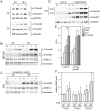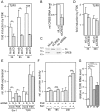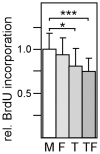Cyclic AMP enhances TGFβ responses of breast cancer cells by upregulating TGFβ receptor I expression
- PMID: 23349840
- PMCID: PMC3548810
- DOI: 10.1371/journal.pone.0054261
Cyclic AMP enhances TGFβ responses of breast cancer cells by upregulating TGFβ receptor I expression
Abstract
Cellular functions are regulated by complex networks of many different signaling pathways. The TGFβ and cAMP pathways are of particular importance in tumor progression. We analyzed the cross-talk between these pathways in breast cancer cells in 2D and 3D cultures. We found that cAMP potentiated TGFβ-dependent gene expression by enhancing Smad3 phosphorylation. Higher levels of total Smad3, as observed in 3D-cultured cells, blocked this effect. Two Smad3 regulating proteins, YAP (Yes-associated protein) and TβRI (TGFβ receptor 1), were responsive to cAMP. While YAP had little effect on TGFβ-dependent expression and Smad3 phosphorylation, a constitutively active form of TβRI mimicked the cAMP effect on TGFβ signaling. In 3D-cultured cells, which show much higher levels of TβRI and cAMP, TβRI was unresponsive to cAMP. Upregulation of TβRI expression by cAMP was dependent on transcription. A proximal TβRI promoter fragment was moderately, but significantly activated by cAMP suggesting that cAMP increases TβRI expression at least partially by activating TβRI transcription. Neither the cAMP-responsive element binding protein (CREB) nor the TβRI-regulating transcription factor Six1 was required for the cAMP effect. An inhibitor of histone deacetylases alone or together with cAMP increased TβRI expression by a similar extent as cAMP alone suggesting that cAMP may exert its effect by interfering with histone acetylation. Along with an additive stimulatory effect of cAMP and TGFβ on p21 expression an additive inhibitory effect of these agents on proliferation was observed. Finally, we show that mesenchymal stem cells that interact with breast cancer cells can simultaneously activate the cAMP and TGFβ pathways. In summary, these data suggest that combined effects of cAMP and TGFβ, as e.g. induced by mesenchymal stem cells, involve the upregulation of TβRI expression on the transcriptional level, likely due to changes in histone acetylation. As a consequence, cancer cell functions such as proliferation are affected.
Conflict of interest statement
Figures











Similar articles
-
APPL proteins promote TGFβ-induced nuclear transport of the TGFβ type I receptor intracellular domain.Oncotarget. 2016 Jan 5;7(1):279-92. doi: 10.18632/oncotarget.6346. Oncotarget. 2016. PMID: 26583432 Free PMC article.
-
Requirement of a dynein light chain in TGFbeta/Smad3 signaling.J Cell Physiol. 2009 Dec;221(3):707-15. doi: 10.1002/jcp.21910. J Cell Physiol. 2009. PMID: 19711352 Free PMC article.
-
TbetaRI/Alk5-independent TbetaRII signaling to ERK1/2 in human skin cells according to distinct levels of TbetaRII expression.J Cell Sci. 2011 Jan 1;124(Pt 1):19-24. doi: 10.1242/jcs.076505. J Cell Sci. 2011. PMID: 21172820 Free PMC article.
-
Role of Ras and Mapks in TGFbeta signaling.Cytokine Growth Factor Rev. 2000 Mar-Jun;11(1-2):23-35. doi: 10.1016/s1359-6101(99)00026-x. Cytokine Growth Factor Rev. 2000. PMID: 10708950 Review.
-
Phospho-specific Smad3 signaling: impact on breast oncogenesis.Cell Cycle. 2012 Jul 1;11(13):2443-51. doi: 10.4161/cc.20546. Epub 2012 Jul 1. Cell Cycle. 2012. PMID: 22659843 Free PMC article. Review.
Cited by
-
Chemoresistance: Intricate Interplay Between Breast Tumor Cells and Adipocytes in the Tumor Microenvironment.Front Endocrinol (Lausanne). 2018 Dec 11;9:758. doi: 10.3389/fendo.2018.00758. eCollection 2018. Front Endocrinol (Lausanne). 2018. PMID: 30619088 Free PMC article. Review.
-
Mesenchymal Stem Cells Relevance in Multicellular Bioengineered 3D In Vitro Tumor Models.Biotechnol J. 2017 Dec;12(12):biot.201700079. doi: 10.1002/biot.201700079. Epub 2017 Sep 4. Biotechnol J. 2017. PMID: 28834355 Free PMC article. Review.
-
A CAF-Fueled TIMP-1/CD63/ITGB1/STAT3 Feedback Loop Promotes Migration and Growth of Breast Cancer Cells.Cancers (Basel). 2022 Oct 11;14(20):4983. doi: 10.3390/cancers14204983. Cancers (Basel). 2022. PMID: 36291767 Free PMC article.
-
cAMP-PKA/EPAC signaling and cancer: the interplay in tumor microenvironment.J Hematol Oncol. 2024 Jan 17;17(1):5. doi: 10.1186/s13045-024-01524-x. J Hematol Oncol. 2024. PMID: 38233872 Free PMC article. Review.
-
MicroRNA-122 inhibits proliferation and invasion in gastric cancer by targeting CREB1.Am J Cancer Res. 2017 Feb 1;7(2):323-333. eCollection 2017. Am J Cancer Res. 2017. Retraction in: Am J Cancer Res. 2021 Jun 15;11(6):3376. PMID: 28337380 Free PMC article. Retracted.
References
-
- Ikushima H, Miyazono K (2010) TGFbeta signalling: a complex web in cancer progression. Nat Rev Cancer 10: 415–424. - PubMed
-
- Schmierer B, Hill CS (2007) TGFbeta-SMAD signal transduction: molecular specificity and functional flexibility. Nat Rev Mol Cell Biol 8: 970–982. - PubMed
-
- Massague J, Seoane J, Wotton D (2005) Smad transcription factors. Genes Dev 19: 2783–2810. - PubMed
-
- Bierie B, Moses HL (2006) Tumour microenvironment: TGFbeta: the molecular Jekyll and Hyde of cancer. Nat Rev Cancer 6: 506–520. - PubMed
Publication types
MeSH terms
Substances
LinkOut - more resources
Full Text Sources
Other Literature Sources
Research Materials

